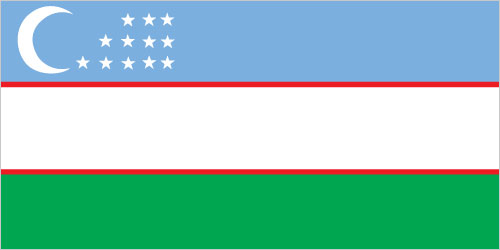Last updated on April 19th, 2022
Uzbekistan, officially also the Republic of Uzbekistan, is a landlocked country in Central Asia. It has an area of 447,400 square km. Tashkent is its capital and largest city. Uzbek and Russian are the official languages of Uzbekistan. Uzbek som (UZS) is its official currency. Its five land bordering countries are Kazakhstan, Kyrgyzstan, Tajikistan, Afghanistan and Turkmenistan.
History
1. Once part of the ancient Persian Empire, what is now known as Uzbekistan was conquered in the fourth century B.C. by Alexander the Great.
2. During the eighth century invading Arab forces dominated the area and converted the nomadic Turkic tribes living there to Islam.
3. In the thirteenth century, Ghengis Khan and the Mongols seized the region from the Seljuk Turks.
4. Next, the territory became part of the empire of Tamerlane the Great and his successors. This lasted into the sixteenth century.

5. In the early sixteenth century the Uzbeks invaded and merged with the other inhabitants of the territory that today is Uzbekistan, breaking it into the separate principalities of the khanates (city-states) Khiva, Kokand and Bukhara.
6. The city-states resisted fiercely but were conquered by the Russian expansion into the area in the mid-19th century.
Flag of Uzbekistan

7. After World War I the population gave stiff resistance to the Red Army but they were eventually suppressed. A socialist Uzbek Republic was set up in 1924. The country became the independent Uzbekistan Soviet Socialist Republic in 1925.
8. Following the breakup of the Soviet Union, Uzbekistan gained its independence in 1991 and became a constitutional republic.
9. President Islam Karimov ran the country from 1991 until his death in 2016. He was widely held to be responsible for severe breaches of basic human rights (tortures and executions).
10. In 2016 Uzbekistan held its first election since 1991.
Read: facts about Pakistan
People and economics
11. Uzbekistan is Central Asia’s most populous country and the majority live in rural areas.

12. The economic trend is for urban residents to earn twice as much as their rural counterparts.
13. Though the Uzbekistan economy grew eight percent in 2015, it is still one of the least developed and poorest countries in Asia.
14. The majority of the country’s citizens are ethnic Uzbeks who speak Uzbek, the official language. Russian is the second most widely spoken language. Sunni Muslims make up 88 percent of the population though they are secular and not religious Muslims.

15. The country is the world’s second-largest cotton exporter and fifth largest producer. Other exports include gold, oil, and natural gas as well as uranium. The nation is resource rich but the money has typically gone to the president and his governmental ruling class.
Facts about culture, tradition, and food in Uzbekistan
16. Having been an historic crossroads for centuries as part of various ancient empires, Uzbekistan’s food is very eclectic. It has its roots in Iranian, Arab, Indian, Russian and Chinese cuisine.

17. Palov or Plov is the national dish. Made of mutton, rice, onions and grated carrots, legend holds it was invented by the cooks of Alexander the Great. Different areas of the country put their own spin on the dish, adding ingredients like pumpkins, peppers or dried tomatoes.
18. Chuchvara is similar to ravioli (Russian pelmeni) and stuffed with onions and mutton. Manti is a dumpling filled with the same. Somsa (samosa) is a pastry pocket filled with mutton or beef, pumpkin or potatoes.

19. Soups include lagman, thick with meat, spices, potatoes, pasta and vegetables (usually with 50 ingredients); mastava , which is rice soup with carrots, tomatoes, onions, peas and even wild plums; and shurpa, a soup made with fatty meat (usually mutton) and fresh vegetables.
20. A Uzbek master chef is held to be able to cook enough palov/plov in one caldron to serve a thousand men.

Read: facts about Afghanistan
21. Lepioshka (bread) is never laid upside down (it brings bad luck) nor placed on the ground, even if it’s safely in a bag.
22. Traditional Uzbek bread, known as ‘obi non’ or simply ‘non’, is flat and round and always torn by hand, never sliced with a knife. It is also never thrown out.

23. Following an ancient tradition, a family member must take a bite from a small piece of Uzbek bread before departing on a journey. The rest of that bread is kept hidden or buried until the traveler comes home.
Etiquette
24. Handshakes are only acceptable as a greeting between two men. An Uzbek woman is greeted by bowing to her with your right hand placed over your heart.
25. In Uzbek tradition, the most respected guest is seated the farthest from the entrance to the house.
26. Respect for the elderly is paramount. An Uzbek never insults nor yells at his parents.
Read: facts about Iran
. . . continue reading on the next page.
